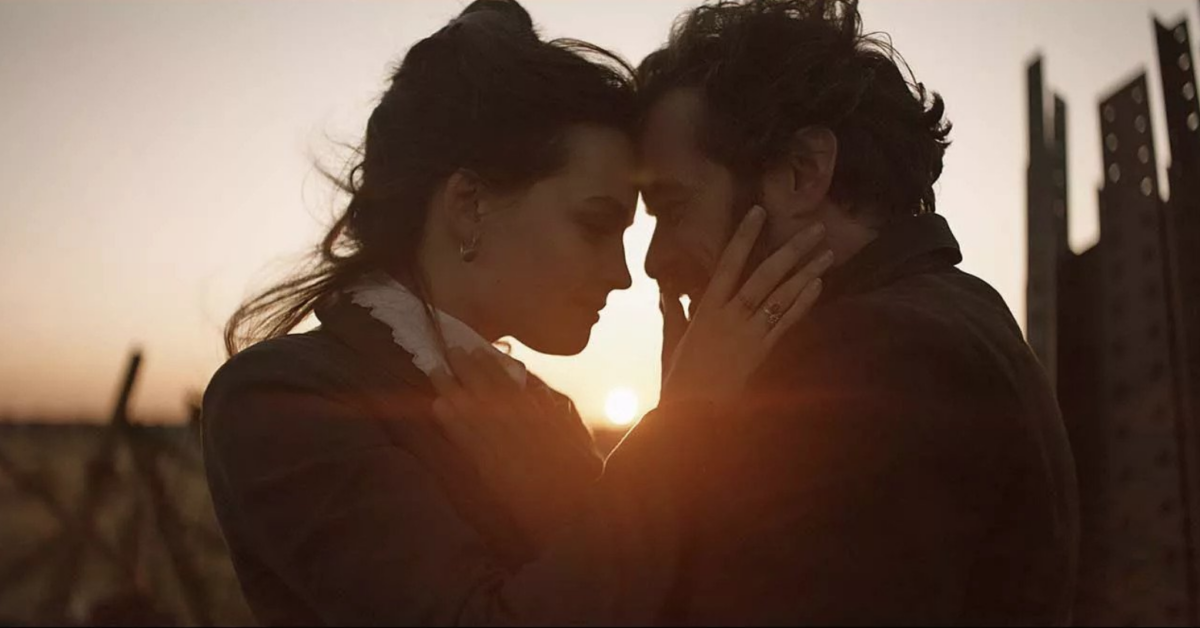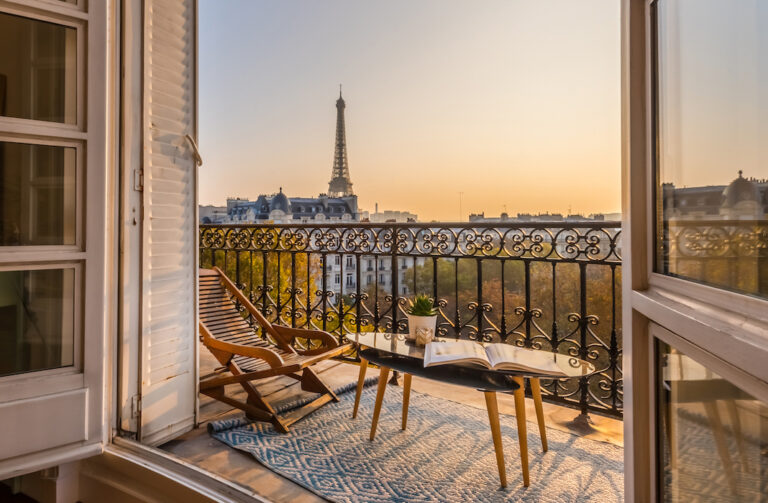Martin Bourboulon’s new movie about Gustav Eiffel and his famous tower announces from the start that it’s “freely inspired by a true story.” Promising the untold story behind the masterpiece, Eiffel opens with the renowned engineer, played by Romain Duris, riding high after the gushing reception of his little gift to the USA—the Statue of Liberty. With the 1889 World’s Fair being held in Paris, everyone expects something equally bold and iconic from him. When an early model of the tower lands on his desk, he declares it ugly. But in the film, as in real life, Eiffel had a sudden change of heart. From one day to the next, he became obsessed with erecting the tower he’d rejected. He announces it will be 300-meters high, the world’s tallest building at the time. His metal tower won’t just be a building. It will defy gravity. It will draw people from all over the world. It will be France’s tower.
The filmmakers seized on the mysterious change of heart, creating a fictional run-in with Eiffel’s onetime love, Adrienne Bourgès, to explain it. In real life, Eiffel did fall in love with Bourgès, when he was 27 and building a bridge near her home in Bordeaux. When her parents opposed their marriage, Eiffel gave up on love, married a family friend with whom he had five children before her death at age 32. In the movie, Adrienne vanishes without a word, then reappears years later, after his wife’s death and around the time the ugly mini-tower turned up on his desk. Played by French-English actress Emma Mackey (best known for the Netflix series, Sex Education), Adrienne is exquisite, an apparition from the past with a tragic explanation for her disappearance all those years ago. The passion between them still burns. While their love remains doomed, it inspires an enduring masterpiece still adored today by all of Paris and the world. Which is something.
Eiffel might not be Palme d’Or material, but there’s magic in scenes of the iconic tower slowly and painstakingly reaching up toward the Parisian sky. This film is the latest in a tradition of movies that pay homage to the Paris landmarks and quartiers that draw millions of tourists to the city every year. Here are a few others it made me remember:
Hugo (2011) – Martin Scorsese’s heartwarming, fantastical movie, based on Brian Selznick’s 2007 book, The Invention of Hugo Cabret, stars Mackey’s Sex Education buddy, Asa Butterfield, as the titular Hugo, a 12-year-old boy who lives alone in the clock tower at the Gare Montparnasse railway station in the 1930s after the death of his father (Jude Law). While setting the station’s clocks, trying to repair an automaton owned by his father, and fleeing a mean-spirited flic played to comic effect by Sascha Baron Cohen, Hugo uncovers a mystery involving the film pioneer, George Meliès. The film is at once a coming of age story, a nail-biting adventure, and a love letter to cinema. The visually-stunning film won five Academy Awards, including Best Picture, Best Cinematography, and Best Visual Effects.
Moulin Rouge! (2001) — Montmartre and the iconic cabaret are the setting for one of my favorite movies of all times, Baz Luhrmann’s musical masterpiece about the swooning love story between Moulin Rouge star performer and courtesan Satine (Nicole Kidman) and starving writer, Christian (Ewan McGregor). The pair has to keep their love a secret when a powerful Duke offers to fund the failing club in exchange for Satine. With Luhrmann’s signature eye-popping visuals and a soundtrack that mixes a mad array of pop songs from the likes of David Bowie, Elton John, Madonna, and the Police with original numbers to stunning effect, this gorgeous slice of the seedier side of the City of Lights is like nothing else ever imagined.
Amélie (2001) – Another of my all-time faves, the quirky romantic comedy by Jean-Pierre Jeunet dips into the cafés and skitters along the cobblestone streets of my beloved one-time quartier, Montmartre, to tell the story of Amélie, a lonely waitress, played by Audrey Tautou, who creates elaborate schemes that bring happiness to the people around her, while neglecting her own. The smart, touching film with a healthy dose of kookiness won four César Awards, including Best Film and Best Director.
Marie Antoinette (2006) – Sofia Coppola’s portrait of the young queen of France puts the spotlight on the famous palace at Versailles. Kirsten Dunst plays the naïve, 15-year-old archduchess of Austria sent to marry the Dauphin of France, the future King Louis XVI (Jason Schwartzman), a shy 15-year-old who refused to have sex with her. Shot largely at the actual palace (some scenes were filmed at other French chateaux, like Vaux-le-Vicomte and Château de Chantilly), the film depicts the queen as an 18th century It Girl, obsessed with clothes, sweets, balls, gambling, and flirting with cute counts, as unrest simmers, boils and, eventually, burns around her.
Diva (1981) — The iconic French thriller by Jean-Jacques Beineix tells the story of Jules, a young postman so obsessed with the American opera singer, Cynthia Hawkins, he illegally records her singing at the Théâtre des Bouffes du Nord, in defiance of her wish to never allow her singing to be recorded. Meanwhile, a prostitute pursued by a corrupt cop drops a recording of testimony that exposes his crime into Jules’ mailbag moments before she is killed. For the rest of the film, Jules is pursued by thugs and heavies throughout Paris, most notably through the Métro. The film is stylish, stressful and, thanks in part to its soaring soundtrack, surprisingly beautiful.
La Haine (1995) – Many films celebrate the beauty and glamour of France’s capital. We’ve all glimpsed scenes of lovers strolling along the quai de la Seine, sipping vin rouge at an outdoor café or gaping at the Mona Lisa. Then there’s La Haine (Hate), a film that lands like a fist to the face, written and directed by Matthieu Kassovitz, who would go on to become a well-known actor in such films as Amélie and the addictive and violent TV series, Le Bureau des Legends. Shot in black and white, the film stars Vincent Cassel, Hubert Koundé and Saïd Taghmaoui as three friends from le banlieue, all from immigrant families, all reeling after their friend is critically injured while in police custody. Riots follow, but Vinz, Hubert and Saïd remain wound up, still searching for an outlet for their rage and sadness. The film, which won the César award for Best Film and the award for Best Director at Cannes, feels especially relevant in the wake of George Floyd and other recent incidents of structural racism and injustice. As far as landmarks in the film, at one point the friends have a blowout, and Hubert and Saïd leave a seething Vinz in Paris standing by a giant 70-ton sandstone statue by Henri Miller of a head resting on a cupped hand. The statue is called Écoute—Listen.
Eiffel opens in theaters on June 3.
Andrea Meyer has written creative treatments for commercial directors, a sex & the movies column for IFC, and a horror screenplay for MGM. Her first novel, Room for Love (St. Martin’s Press) is a romantic comedy based on an article she wrote for the New York Post, for which she pretended to look for a roommate as a ploy to meet men. A long-time film and entertainment journalist and former indieWIRE editor, Andrea has interviewed more actors and directors than she can remember. Her articles and essays have appeared in such publications as Elle, Glamour, Variety, Time Out NY, and the Boston Globe.






